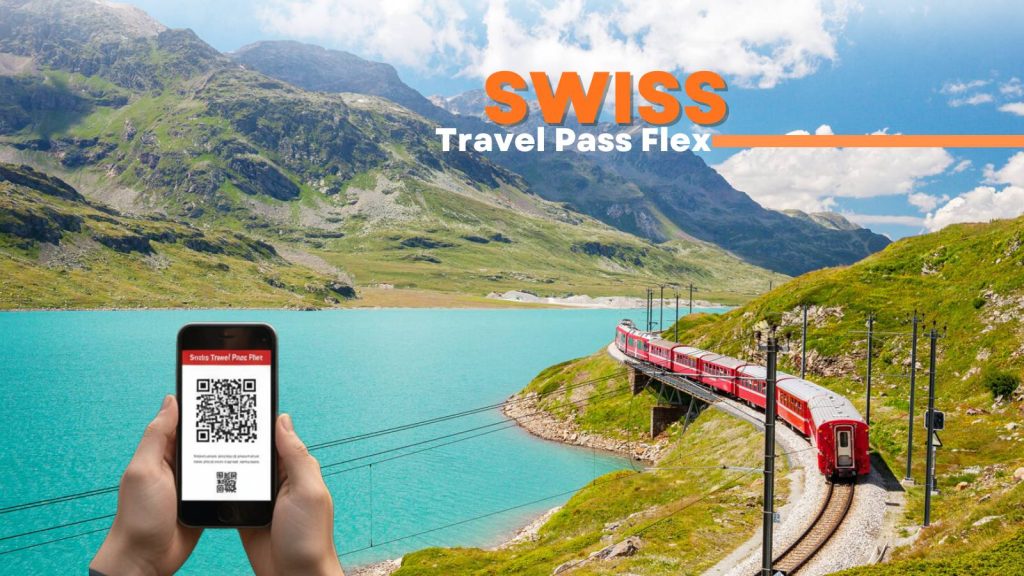Switzerland is a land of pristine lakes, majestic mountains, and picturesque villages. Traveling across this country is an unforgettable experience, but navigating its transport system can be challenging without the right pass. Among the various options, the Swiss Travel Pass Flex stands out for its flexibility and convenience.
This pass allows travelers to explore Switzerland at their own pace without worrying about consecutive travel days. Here are everything you need to know about the Swiss Travel Pass Flex, including pricing, benefits, usage, activation, comparison with the standard Swiss Travel Pass.
What is the Swiss Travel Pass Flex?
The Swiss Travel Pass Flex is an enhanced version of the standard Swiss Travel Pass. While the traditional pass is valid for consecutive days, the Flex pass allows travelers to select non-consecutive travel days within a one-month validity period. This is especially useful for travelers who plan to spend several days in a single location or want to take day trips without using the pass daily.
The pass is part of the Swiss Travel System, which covers almost all public transport, including trains, buses, boats, and even some mountain excursions. It’s designed to offer convenience, freedom, and cost savings. Travelers can explore cities like Zurich, Lucerne, and Geneva or take scenic journeys like the Glacier Express and Golden Pass Line with a single pass.
Additionally, the Swiss Travel Pass Flex provides access to more than 500 museums across Switzerland, adding cultural value to your travel experience.
Swiss Travel Pass Flex Price: How Much Does It Cost?
Pricing for the Swiss Travel Pass Flex varies depending on the number of travel days, class of travel, and age category. Here’s a detailed breakdown:
- Duration Options: Travelers can choose from 3, 4, 8, or 15 flexible travel days within one month.
- Second-Class Adult Prices: CHF 232 for 3 days, CHF 281 for 4 days, CHF 418 for 8 days, and CHF 538 for 15 days.
- First-Class Adult Prices: CHF 369 for 3 days, CHF 448 for 4 days, CHF 668 for 8 days, and CHF 859 for 15 days.
- Youth Discounts: Travelers under 26 years receive significant discounts, making it affordable for students and young explorers.
- Child Benefits: Children under 16 often travel free when accompanied by a parent, allowing families to save considerably.
It’s recommended to purchase the pass online in advance, as it guarantees availability and sometimes offers promotional discounts. For travelers on a budget, planning travel on non-consecutive days using the Flex pass can be more economical than buying individual tickets.
Swiss Travel Pass Flex Benefits: Why You Should Consider It
The Swiss Travel Pass Flex offers a wide range of benefits that make traveling in Switzerland seamless and enjoyable:
Unlimited Travel Across Switzerland: The pass covers nearly all trains, buses, and boats, allowing travelers to move freely without purchasing individual tickets. Popular routes like Zurich to Lucerne or Geneva to Interlaken are fully covered.
Access to Over 500 Museums: Travelers can enjoy free entry to museums, exhibitions, and galleries across Switzerland, from art museums in Zurich to historical sites in Bern. This adds cultural depth to your travel experience.
Flexible Travel Days: Unlike the standard Swiss Travel Pass, the Flex pass allows travelers to select non-consecutive travel days. This is ideal for slow-paced itineraries, overnight stays in scenic towns, or relaxing in mountain resorts.
Discounts on Mountain Excursions: Many iconic Swiss mountains, including Jungfraujoch, Mount Pilatus, Schilthorn, and Rigi, offer discounted rates for pass holders, making it easier to explore these attractions without overspending.
Convenience and Time-Saving: With one pass covering multiple modes of transportation, travelers don’t have to worry about lining up for tickets or dealing with multiple bookings. The pass also allows travelers to spontaneously decide on day trips.
Sustainable Travel: Using public transport reduces carbon footprints, making the Flex pass a more eco-friendly travel option compared to renting cars or taxis.
How to Use the Swiss Travel Pass Flex
Using the Swiss Travel Pass Flex is intuitive, but understanding its mechanics can enhance your travel experience:
1. Plan Your Travel Days: Select the travel days based on your itinerary. For example, you might use the pass on days you plan to travel between cities and take regular tickets on days spent exploring locally.
2. Boarding Public Transport: Simply show your pass to the conductor when traveling. No need for separate tickets or reservations for standard trains.
3. Day Planning: Use the Swiss Travel System online planner or mobile apps like SBB Mobile to organize your trips efficiently. These tools also provide real-time train schedules, helping you avoid delays.
4. Combine Transport Modes: You can seamlessly use trains, buses, boats, and some mountain cable cars or funiculars with the pass. Some premium mountain excursions may require an additional discount ticket.
5. Keep Travel Days Updated: For physical passes, make sure to write the travel date clearly. For digital passes, activation occurs automatically on the first travel day.
Travelers should remember that peak-season trains and popular routes might require seat reservations, which are not included in the pass. Booking these in advance ensures a smooth journey.
Swiss Travel Pass Flex Activation: Quick and Easy Steps
Activating the Swiss Travel Pass Flex is simple and can be done online or at train stations:
1. Purchase Your Pass: Buy from the official Swiss Travel System website or authorized resellers. Digital passes can be stored on smartphones, while physical cards are mailed to your address.
2. Activate Before First Use: For physical passes, manually write the date of the first travel day. For digital passes, activation occurs automatically on the first day of travel.
3. Check Validity: Ensure that all selected travel days fall within the one-month validity period.
4. Carry Identification: Always have a valid ID, as it may be requested alongside your pass during ticket inspections.
By following these simple steps, you can activate your pass efficiently and avoid issues during your travels.
Swiss Travel Pass Flex vs Swiss Travel Pass: Which One Should You Choose?
Travelers often ask about the difference between the Swiss Travel Pass Flex and the standard Swiss Travel Pass. Here’s a detailed comparison:
| Feature | Swiss Travel Pass Flex | Swiss Travel Pass |
|---|---|---|
| Travel Days | Non-consecutive within one month | Consecutive days only |
| Pricing | Slightly higher for flexibility | Slightly lower for consecutive travel |
| Ideal For | Leisure travelers, families, slow itineraries | Travelers with tight schedules |
| Museum Access | Included | Included |
| Mountain Excursion Discounts | Included | Included |
| Flexibility | High – choose any travel day | Limited – must travel daily |
If itinerary involves multiple destinations with breaks in between or you want to stay longer in scenic towns, the Swiss Travel Pass Flex is ideal. On the other hand, the standard pass is better for travelers planning daily consecutive trips.
By carefully planning your travel days and leveraging the pass’s benefits, you can enjoy Switzerland like a local without worrying about ticket logistics or transportation costs.
FAQs
1. Can I use the pass for consecutive travel days?
Yes, you can, but the main advantage of the Flex pass is the ability to skip days without losing validity.
2. Can I combine it with regional passes or other travel passes?
Yes, combining it with regional passes can offer additional savings and access to local routes not fully covered by the Flex pass.
3. Are seat reservations included?
Standard trains don’t require reservations, but scenic or panoramic trains like the Glacier Express may need a reservation, which is an extra cost.
4. What happens if I miss a travel day?
Unused travel days remain valid until the end of the one-month period. However, once the month expires, remaining days cannot be refunded.
5. Can I use it for day trips to neighboring countries?
Yes, some routes into nearby countries, like Germany, France, or Italy, are partially covered. However, check the specific route coverage before traveling.
6. Is the pass refundable?
Refund policies vary by provider. Generally, refunds are only available if the pass hasn’t been activated, and some service fees may apply.
7. Can I use it during peak seasons?
Yes, the pass is valid year-round, including holidays and peak tourist seasons. Just ensure reservations for high-demand scenic trains.





